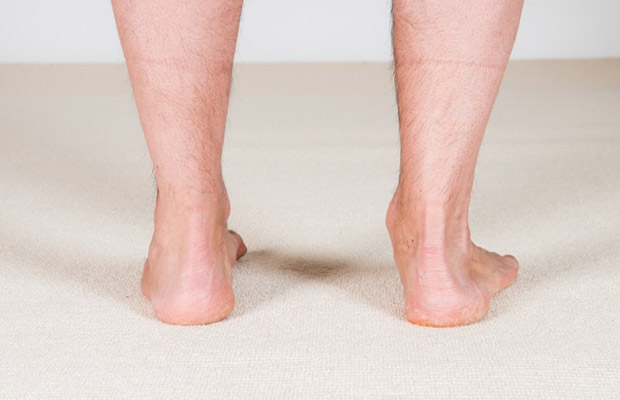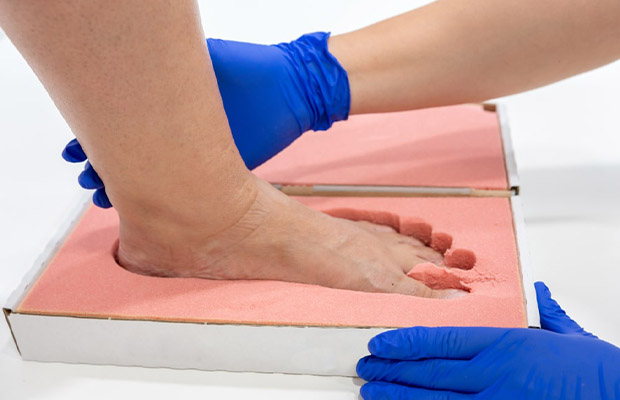Flat Feet And Overpronation – Difference And Relationship

When a person walks, runs, or stands still, their foot leans too far to the center, which is known as overpronation. Overpronation and flat feet are two distinct conditions, though they frequently coexist.
What is the difference between flat feet and overpronation? Flat feet can result from overpronation, which is a gait disorder. When your foot has little to no arch, you have flat feet, which is a medical condition. Flat feet can be inherited or developed over time.
Keep reading and learn more about flat feet and overpronation.
Table of Contents
What Is Overpronation?
Overpronation occurs when the arches of your feet eventually flatten more than they would normally due to your gait (the way you walk or run). That puts stress on the tendons, ligaments, and muscles that support your arches. Your risk of suffering foot and leg injuries rises when you overpronate. However, you can fix the issue by working out and fitting your shoes with orthotic insoles.
Relationship Between Flat Feet And Overpronation
Most people who have flat feet, like me, have flexible flat feet. If their foot is off the ground, they have an arch, or they can form an arch, but the arch collapses when they stand.
Here, overpronation and flexible flat feet are closely related. My foot pronated a lot when I walked, which was one of the reasons I lacked an arch.
Therefore, when I discuss flat feet correction, I typically mean both of the following:
- Increasing the height of the arch in standing, and
- Controlling the amount of pronation with walking or running.
Though not always, the two conditions are connected. Both overpronation and flat feet are possible in a person, as well as either one on its own.
So it’s possible to have a normal-sized arch and a visible arch in a footprint but overpronate when engaging in activities like running that involve more force being applied to the foot.

Causes Of Overpronation
Your feet may become flat due to overpronation. Overpronation frequently begins in people with slightly flat feet. The likelihood of developing overpronation is higher if you already have flat feet.
Symptoms Of Overpronation
Your shoes’ bottoms could be the first indication that you have overpronation. You may have overpronation if the inside of your shoe’s soles shows more wear than the outside.
There are additional symptoms that you might experience as a result of overpronation. There are numerous ailments and signs that are associated with overpronation, including:
- Achilles tendinitis: This condition develops when your Achilles tendon is under stress.
- Bunions: On the outside of your big toe, bunions are uncomfortable bony lumps.
- You may experience pain inside, behind, or beneath your heel bone.
- Syndrome of the iliotibial band: This is an inflammation of a knee ligament on the outside.
- The tendon that runs from your heel to your toe is called your plantar fascia, and it can become inflamed.
- Shin splints: An overuse injury that is common.
- Hip pain: Overpronation may cause hip pain.
- Knee pain: Overpronation puts you at risk for knee pain.
- Overpronation may occasionally result in back pain.
Treatment For Overpronation
Most people do not need treatment for flat feet, but the following options may help manage pain and reduce the chance of an injury:
- Choosing supportive or motion control shoes, also known as overpronation shoes
- Using orthotics
- Managing pain with nonsteroidal anti-inflammatory drugs (NSAIDs)
- Managing weight through diet and exercise, if appropriate
- Surgery, in some cases
- Doing exercises that strengthen the arches and muscles around them
Footwear
When engaging in repetitive foot strikes, like running or walking, a person with overpronation should wear supportive footwear.
To lessen the impact of each step, the person should wear shoes that provide additional support and stability.
Supportive footwear for overpronators has the following qualities:
- checking that the shoe has a strong and inflexible heel counter, the hard piece in the back that stops the foot from moving from side to side
- choosing shoes with a dense midsole, as it will uphold the arch
- opting for a wide base of support for the middle of the foot to prevent the arch from collapsing inward
Here are some additional shoe-buying advice:
- asking the sales associate to measure both feet
- shopping for shoes at the end of the day when feet are more likely to be a little puffy
- wearing thin socks when shopping for shoes, as thick socks can lead to choosing shoes that are too tight
- choosing a specialty walking or running store, which is more likely to have equipment for assessing gait
Some athletic stores sell gear that shows exactly where on the foot a person is walking when they do so. This can demonstrate whether a person requires footwear with a particular kind of support.
The most noticeable wear can also be seen by looking at the soles of one’s shoes. Overpronation may manifest itself as wear on the inside edge.
A podiatrist or orthopedic surgeon can also recommend suitable shoes, such as anti-pronation shoes, which experts suggest may help reduce physical fatigue due to overpronation.
Exercises For Overpronation
For people with overpronation, a physical therapist may occasionally suggest strengthening exercises. These exercises can support their foot arches and the muscles that do so.
Here are some workouts that could be useful:
Heel Stretches
- Place your feet flat on the ground as you stand.
- Move one foot forward so that it is roughly one pace in front of the other.
- All of your weight should be on the front foot as you push forward while maintaining a straight spine.
- The back leg and Achilles tendon should feel stretched.
- Hold for 30 seconds.
- Four times, switching feet each time.
Calf Raises
- Stand with both feet on the ground
- One heel at a time, raise them as high as you can, hold for five seconds, then bring them down.
- Continue for 15 to 20 times.
- Alternately, you can use a stair or exercise step and raise your heels so they are level with the step.
Toe Raises
- Put both of your feet firmly on the ground.
- Lift the other toes of the right foot while pressing the right big toe into the ground.
- Hold for 5 seconds.
- The next step is to plant your four smaller toes on the ground while lifting your big toe for five seconds.
- Each exercise should be repeated 5–10 times.
- With the other foot, switch and repeat.
58 young athletes aged 9 to 12 participated in an exercise program for a 2015 study. Overpronation affected the gait of 10 of the participants. All of the participants had typical gaits after 6 months, indicating that certain exercises may help children’s gait and lessen overpronation.
Tennis Ball Roll
- Flat feet on the floor while seated.
- Put a tennis or golf ball underneath one foot.
- For two to three minutes, roll the ball back and forth under the foot while maintaining a straight spine.
- Change, then repeat with the other foot.
Wearing Orthotics
In order to provide additional arch support and lessen the negative effects of a person’s gait, orthotics are special inserts that fit into shoes.
Generic orthotics are accessible without a prescription and might offer sufficient support to stop injuries brought on by overpronation.
However, a podiatrist may decide that an individual with overpronation needs a specific pair of custom orthotics after assessing the individual’s walking pattern.
A 2015 study looked at 20 children with flexible flat feet who wore custom-made orthoses for 3 months. Tests conducted at the conclusion of the study revealed they had better balance and less pain.
Prevention For Overpronation
Despite the fact that overpronation cannot always be avoided, its effects can be lessened with the aid of supportive footwear and orthotics.
Adhering to a suggested exercise regimen may help to strengthen the foot and reduce the chance of injury.
Maintaining a healthy weight can also help lower the risk.
The Bottom Line
Due to its ability to alter the body’s natural alignment and increase the impact when the foot strikes the ground, overpronation can increase the risk of certain injuries.
A physician can offer guidance on appropriate footwear and orthotics to support the feet. If necessary, they may suggest alternatives to aid in pain relief and injury prevention.
Read More: How To Walk In Heels With Flat Feet?
Tags: Flat Feet, Overpronation